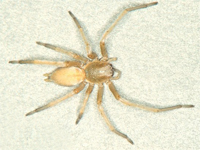|  Yellow
Sac Spiders Yellow
Sac Spiders
Order: Araneae
Family: Clubionidae
Scientific Name: Chiracanthium spp. and Trachelas
spp.
Color: Pale yellow to pale green or orange brown
to reddish
Legs: 8
Shape: Typical spider
Size: 1/8-5/16" long
Antennae: No
Flight: No
The common name comes from the retreat they build which is a flattened
silk tube or sac where they spend most daylight hours; they do not
build webs. These spiders are more than nuisance pests because 3
species are probably responsible for a great many cases of indoor
spider bites.
Habits
Normally, these are outdoor spiders, but sac spiders often invade
structures. Their numbers increase significantly in the fall when
the weather turns cool and their food supply disappears. If there
are small insects available, sac spiders can become established
indoors.
At night, sac spiders actively hunt their preyóusually small
insects. In search of prey, they run quickly waving their forelegs
before them. Indoors, they can be observed on walls and ceilings,
but drop to the floor to seek cover when disturbed
Habitat
Once indoors, sac spiders may build retreats in the upper corners
and the ceiling-wall junctions of rooms and rest there during the
day. In basements and crawl spaces, spiders are found where joists
and band boards meet the subflorring.
Threats
Experts believe sac spiders cause more bites than any other type
of spider and their bites are often misdiagnosed as brown recluse
spider bites.
The venom of sac spiders contains a cytotoxin, which means it kills
cells, like the venom of a brown recluse. Unlike brown recluse bites
which can take 2-3 months to heal, most sac spider bites heal much
more quickly, although the reaction will vary greatly from individual
to individual. Typical symptoms of a sac spider bite include a stinging
sensation followed by redness and mild swelling. In a few cases,
the bite may blister and break, leaving a sore that can take several
weeks to heal. Sometimes the person will feel mildly ill.
Control
During the day, sac spiders may be inside their sacs so vacuuming
is an excellent method of control. Remove and discard vacuum cleaner
bags to prevent reinfestation. To help reduce numbers entering a
structure, exclude by screening vents, caulking around utility entrances
and door/window frames.
(Source: National Pest Management Association, et. al.)
|